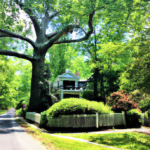Building a Tiny House
How Come Eugene Oregon Allow Tiny House Village

I am enthusiastic about investigating how Eugene, Oregon is addressing the issue of affordable housing by permitting tiny house villages.
In this article, we will delve into the reasons behind Eugene’s decision, including the sustainable living and environmental benefits, the support and collaboration of the community, and the role of local government.
Join me as we discover how Eugene is serving its residents by providing innovative and practical housing options.
Key Takeaways
- The affordable housing crisis in Eugene has led to a high demand for affordable housing and limited supply, causing housing instability and homelessness.
- Tiny house villages in Eugene offer affordable and sustainable housing options, promoting social integration, access to services, and self-sufficiency.
- Living in tiny houses encourages a minimalist lifestyle and utilizes off-grid systems, contributing to sustainable living and environmental benefits.
- Local government in Eugene plays a crucial role in allowing and supporting the development of tiny house villages through zoning regulations, policy development, and community support.
The Affordable Housing Crisis in Eugene
I’m experiencing firsthand the devastating effects of the affordable housing crisis in Eugene.
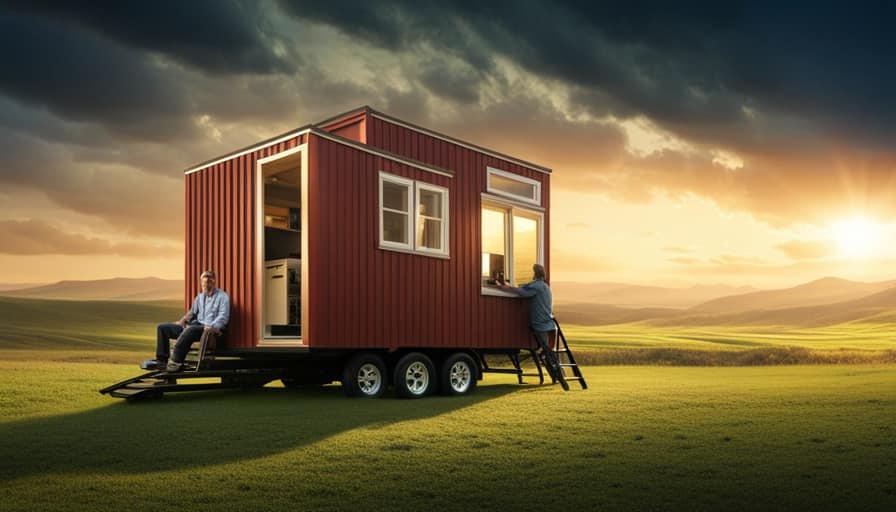
The housing market in Eugene has become increasingly unaffordable, leaving many individuals and families struggling to find suitable and affordable housing options. The cost of housing has skyrocketed, outpacing the growth of wages and making it difficult for people to make ends meet.
This has resulted in a high demand for affordable housing and a limited supply, exacerbating the crisis. Eugene’s housing market has become highly competitive, with rental prices soaring and home ownership becoming increasingly out of reach for many.
The lack of affordable housing options is causing individuals and families to face housing instability, homelessness, and a decline in their overall quality of life.
Addressing the issue of housing affordability in Eugene is crucial to ensuring that everyone in the community has access to safe and affordable housing options.

Addressing Homelessness Through Tiny House Villages
How can tiny house villages effectively address homelessness in Eugene, Oregon?
Tiny house villages present innovative solutions to address homelessness by providing affordable and sustainable housing options for individuals experiencing homelessness. These villages consist of small, self-contained homes that offer residents a safe and stable place to live.
By offering a sense of ownership and privacy, tiny house villages promote social integration and a sense of community among residents. They provide a supportive environment where individuals can access necessary services and resources to help them transition out of homelessness.
Moreover, tiny house villages encourage self-sufficiency and empowerment through the provision of communal spaces, such as shared kitchens and community gardens, fostering social interaction and collaboration.

This approach to addressing homelessness promotes dignity and respect for individuals while offering a pathway to long-term stability.
Sustainable Living and Environmental Benefits
Living in a tiny house village allows for a more sustainable lifestyle, and it also offers numerous environmental benefits. Here are some reasons why:
-
Minimalist lifestyle: Living in a tiny house encourages a minimalistic approach to life. With limited space, people learn to prioritize their belongings and reduce unnecessary consumption. This mindset promotes sustainability by reducing waste and resource consumption.
-
Off-grid living: Many tiny house villages utilize off-grid systems, such as solar panels and rainwater collection, to meet their energy and water needs. This reduces reliance on traditional utilities and minimizes the environmental impact.

-
Reduced carbon footprint: Tiny houses have a smaller footprint compared to traditional homes. They require less energy for heating, cooling, and maintenance, resulting in lower carbon emissions. Additionally, tiny house villages often promote sustainable transportation options like biking or public transit, further reducing carbon emissions.
Community Support and Collaboration in Eugene
While living in a tiny house village in Eugene, I have witnessed the incredible community support and collaboration that exists among the residents. The village fosters a strong sense of community engagement, where individuals come together to support and uplift one another. Residents collaborate on various projects and initiatives, working towards innovative solutions that benefit the entire community.
To give you a clearer picture, here is a table highlighting some examples of community engagement and collaborative efforts in our tiny house village:
| Community Engagement | Innovative Solutions |
|---|---|
| Regular community meetings to discuss village improvements | Implementation of communal gardens to promote sustainability and food security |
| Volunteer-led workshops and skill-sharing sessions | Development of a neighborhood watch program to ensure safety and security |
| Joint fundraising efforts to support village maintenance and expansion | Creation of a shared resource library for residents to borrow tools and equipment |
The community support and collaboration in our tiny house village not only create a strong sense of belonging but also contribute to the overall well-being and success of the residents.

The Role of Local Government in Allowing Tiny House Villages
Having worked closely with the local government in Eugene, I’ve seen the instrumental role they play in allowing tiny house villages to exist and thrive. The local government’s role in enabling these villages involves several key aspects:
-
Role of Zoning: The local government plays a crucial role in determining the zoning regulations that govern land use within the city. By creating specific zoning categories that allow for tiny house villages, they provide a legal framework for these communities to be established.
-
Public Opinion: The local government takes into account the opinions and feedback of the community when making decisions regarding tiny house villages. They engage in public consultations and seek input from residents to ensure that the establishment of these villages aligns with the desires and needs of the community.
-
Policy Development: The local government develops policies and guidelines to regulate the establishment and operation of tiny house villages. These policies address important aspects such as health and safety standards, environmental sustainability, and community integration.

Frequently Asked Questions
How Many Tiny Houses Are Typically Included in a Tiny House Village in Eugene?
Typically, a tiny house village in Eugene includes around 10 to 15 houses. Eligibility criteria usually require individuals to be experiencing homelessness. Funding for these villages often comes from a combination of government grants and community donations. Amenities vary but can include shared kitchens, bathrooms, and community spaces. Future expansion plans aim to create more villages to address the affordable housing crisis. Compared to other options, tiny house villages provide a unique and innovative solution to homelessness in Eugene.
Are There Any Specific Eligibility Criteria for Individuals to Qualify for Housing in a Tiny House Village?
To qualify for housing in a tiny house village in Eugene, individuals must meet specific eligibility criteria. The application process involves fulfilling requirements such as income limits, background checks, and demonstrating a need for affordable housing.
How Are the Tiny House Villages in Eugene Funded?
Tiny house villages in Eugene, Oregon are funded through a combination of government grants, private donations, and community support. These funding sources help provide affordable housing options and promote a sense of community within the village.
What Kind of Amenities and Services Are Available to Residents in the Tiny House Villages?
Living in a tiny house village in Eugene, Oregon comes with a range of amenities and services. Residents have access to community engagement opportunities, such as shared gardens and common spaces, as well as environmental sustainability initiatives like composting and recycling programs.

Are There Any Plans to Expand the Number of Tiny House Villages in Eugene in the Future?
There are plans to expand the number of tiny house villages in Eugene in the future. The city has received a lot of community support for these projects, making future expansion more likely.
Conclusion
In conclusion, Eugene, Oregon’s decision to allow tiny house villages is a beacon of hope in the darkness of the affordable housing crisis.
Like a tiny seed growing into a mighty oak, these villages provide a sustainable solution to homelessness and promote environmentally-friendly living.
With the support and collaboration of the community, Eugene’s local government has taken a bold step towards creating a more inclusive and compassionate society.

Let’s continue to nurture this seed of change, so that it may blossom into a brighter future for all.
I’m Theodore, and I love tiny houses. In fact, I’m the author of Tiny House 43, a book about tiny houses that are also tree houses. I think they’re magical places where imaginations can run wild and adventures are just waiting to happen.
While tree houses are often associated with childhood, they can be the perfect adult retreat. They offer a cozy space to relax and unwind, surrounded by nature. And since they’re typically built on stilts or raised platforms, they offer stunning views that traditional homes simply can’t match.
If you’re looking for a unique and romantic getaway, a tree house tiny house might just be the perfect option.
Common Challenges
How Did These Tiny Ants Get Into My House

Have you ever thought about how these annoying little ants are able to get into your home? It’s almost like they have a secret underground system, maneuvering through cracks and crevices like expert spies.
Well, fear not, my friend, for I have the answers you seek. In this article, I will delve into the common entry points ants use to invade your abode, their sneaky tactics for finding food and water sources indoors, and the outdoor factors that entice them to your humble abode.
Get ready to uncover the secrets of these tiny intruders and learn effective strategies to keep them at bay.
Key Takeaways
- Ants can enter homes through tiny cracks and gaps, as well as crawl through electrical outlets and plumbing pipes.
- Ants are attracted to food sources and can hitch a ride on items brought inside.
- Different species of ants, such as carpenter ants, odorous ants, and pavement ants, can invade homes.
- Prevention measures include keeping the home clean, sealing cracks and gaps, storing food properly, and fixing any leaks or moisture issues.
Common Entry Points for Ants in Your Home
I’ve noticed that the most common entry points for ants in my home are through small cracks in the walls and gaps around windows and doors. Ants are tiny creatures, but they can find their way into our homes through even the tiniest of openings. They’re attracted to food sources and will go to great lengths to get to them.
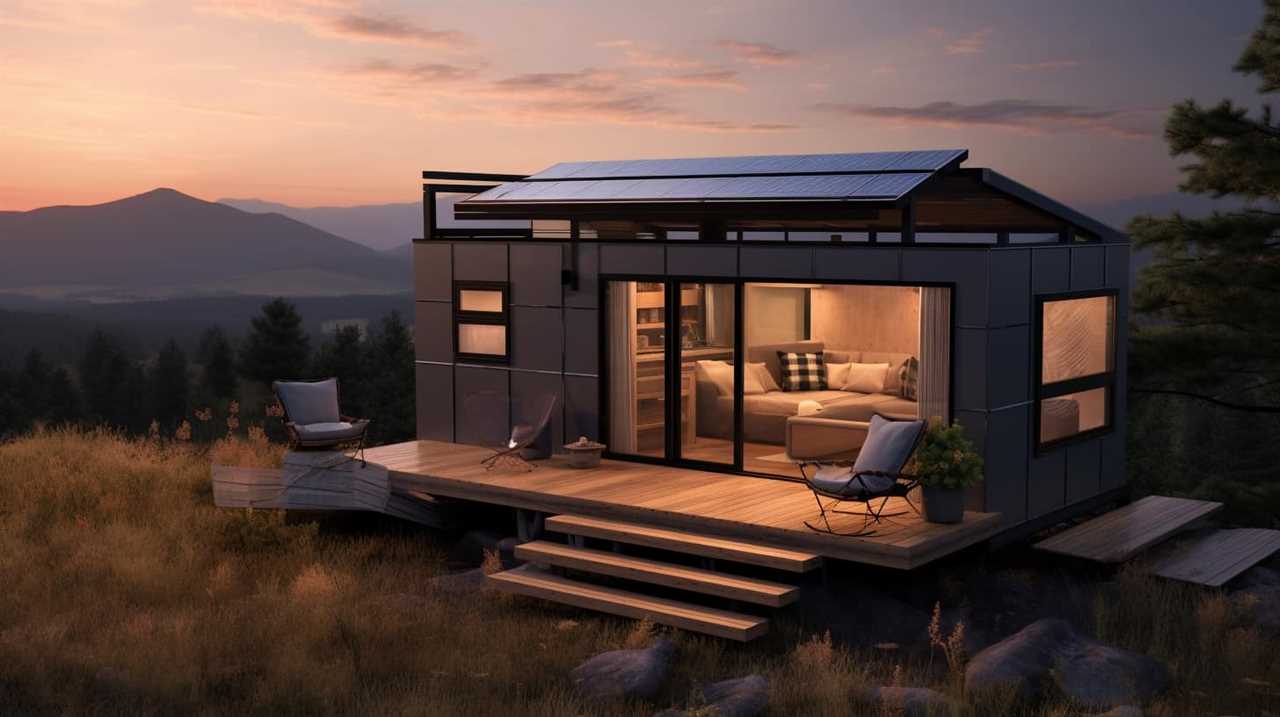
To prevent ants from entering your home, it’s important to seal off these common entry points. Use caulk or weatherstripping to seal up cracks in the walls and gaps around windows and doors. This will create a barrier that ants can’t penetrate.
Additionally, keeping your home clean and free of food debris will also discourage ants from entering. Regularly sweep and mop floors, wipe down countertops, and store food in airtight containers.
Sneaky Ways Ants Can Find Food and Water Sources Inside
Sometimes, ants can find food and water sources inside my house by using their keen sense of smell and following scent trails left by other ants. Ant behavior plays a crucial role in their search for nourishment, as they communicate and coordinate inside their colonies.
Here are three sneaky ways ants can find food and water sources inside:
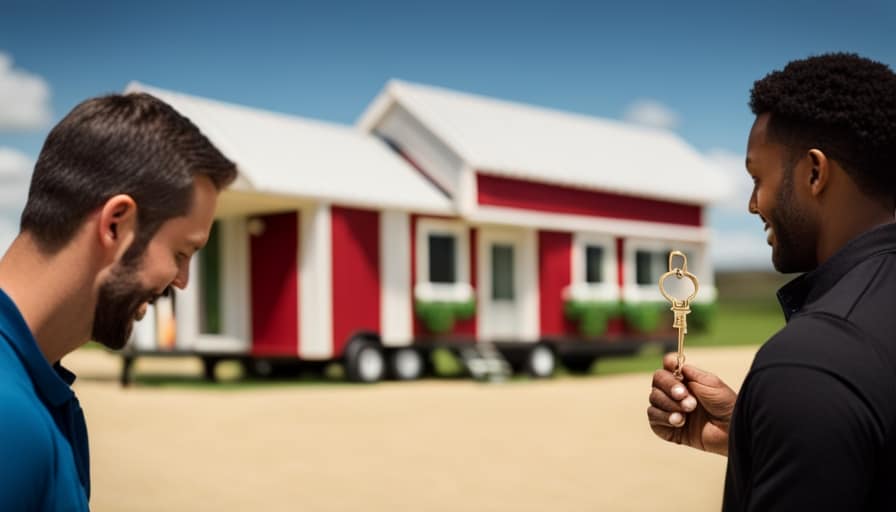
-
Trail Following: Ants leave pheromone trails to guide their colony members to food sources. By following these scent trails, ants can quickly locate and access food and water inside your house.
-
Foraging Scouts: Some ants send out scouts to search for new food and water sources. These scouts leave the colony and explore the surroundings, looking for potential sources of nourishment. Once they find something, they return to the colony and recruit others to join them.
-
Opportunistic Feeding: Ants are opportunistic creatures and will exploit any available food and water sources they come across inside your home. They can squeeze through tiny cracks and crevices, making it easy for them to access your kitchen, pantry, or any area where food and water are stored.
To prevent ants from finding food and water sources inside, consider using DIY ant control methods such as natural remedies and home remedies for getting rid of ants.
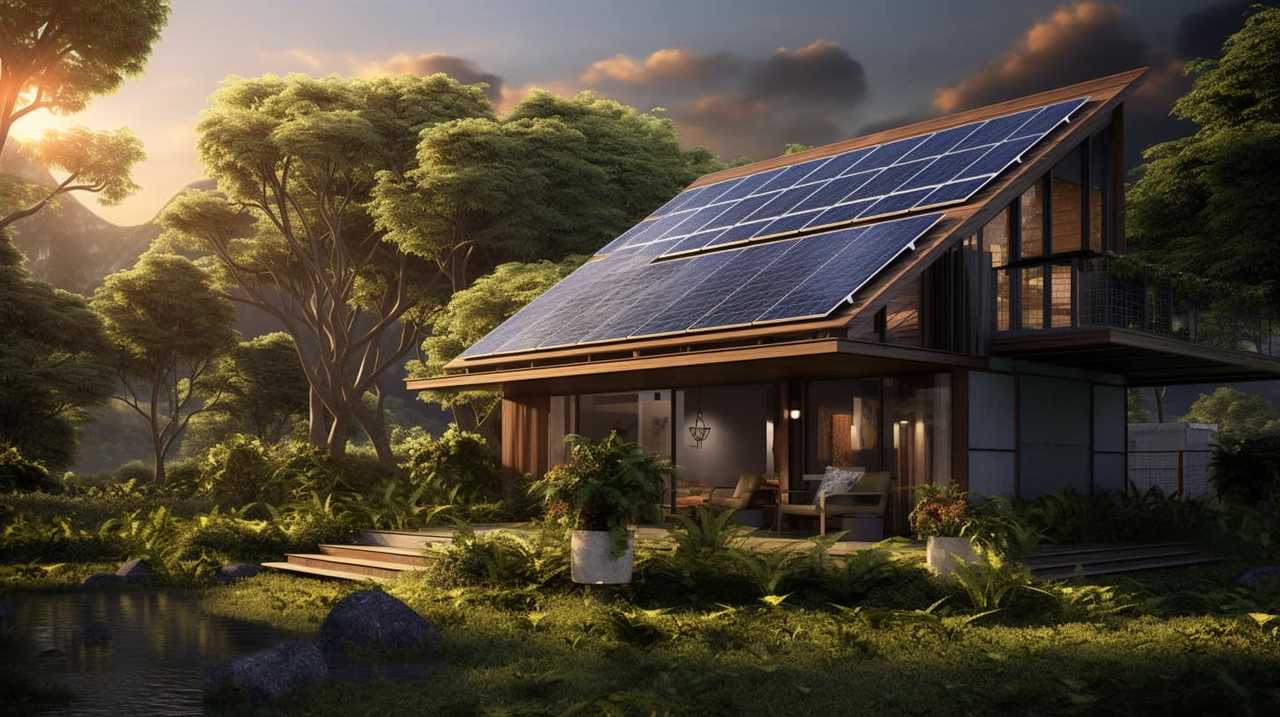
Outdoor Factors That Attract Ants to Your House
One major outdoor factor that attracts ants to my house is the presence of easily accessible food and water sources. Ants have an incredible ability to detect attractive scents from a distance, and they’ll follow these scents to find their way to potential food sources. It’s important to keep outdoor areas clean and free from food debris to minimize ant activity.
Additionally, standing water or leaky faucets can also attract ants, as they’re in constant search of water sources. To deter ants from entering your house, there are several natural remedies you can try. Peppermint oil, vinegar, and lemon juice are all known to repel ants due to their strong scent.
Understanding Ant Behavior: How They Form Trails and Colonies Indoors
To truly understand ant behavior and how they establish trails and colonies indoors, it’s important to observe their movement patterns and track their pheromone trails. Ants communicate through chemical signals, using pheromones to coordinate their activities.
Here are three key points to help you understand ant behavior indoors:

-
Chemical Communication: Ants release pheromones that act as signals, allowing them to communicate with each other. These chemical trails help ants navigate, find food sources, and locate potential nest sites.
-
Weather’s Influence: Changes in temperature and humidity can greatly impact ant behavior indoors. Ants are sensitive to these environmental factors and may seek shelter or move their colonies to more favorable conditions.
-
Movement Patterns: Ants establish trails indoors by following the pheromone scent left by other ants. As more ants travel along the same path, the scent becomes stronger, attracting even more ants and reinforcing the trail.
Effective Strategies to Prevent Ant Infestations in Your Home
How can I effectively prevent ant infestations in my home?
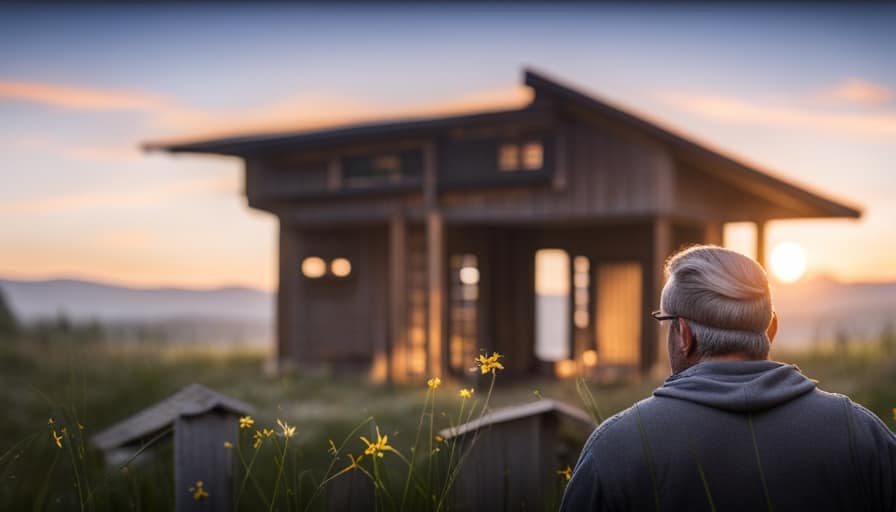
Ants can be persistent pests, but there are strategies you can employ to keep them out.
One effective method is to maintain a clean and tidy home. This means regularly cleaning up spills, crumbs, and food debris, as these can attract ants.
Additionally, sealing cracks and crevices in your home’s foundation and walls can help prevent ants from entering.
Another option is to use natural remedies, such as vinegar or lemon juice, to deter ants from entering your home. These substances disrupt their scent trails, making it harder for them to find their way inside.

If all else fails, professional pest control services can provide targeted treatments to eliminate ant infestations and prevent future ones.
Frequently Asked Questions
Can Ants Cause Any Damage to My House?
Yes, ants can cause structural damage to your house. Signs of ants in the house include visible trails, small piles of dirt near cracks, and chewed wood or insulation.
How Do Ants Communicate With Each Other?
Ants, like tiny dancers in a secret ballet, use an intricate language of pheromones to communicate. These chemical signals guide them to food sources, alert others to danger, and help them navigate their world.
What Types of Ants Are Commonly Found in Homes?
Ant species commonly found in homes include odorous house ants, pavement ants, and Argentine ants. To prevent ants from entering, keep food sealed, clean up spills promptly, and use ant baits or sprays near entry points.
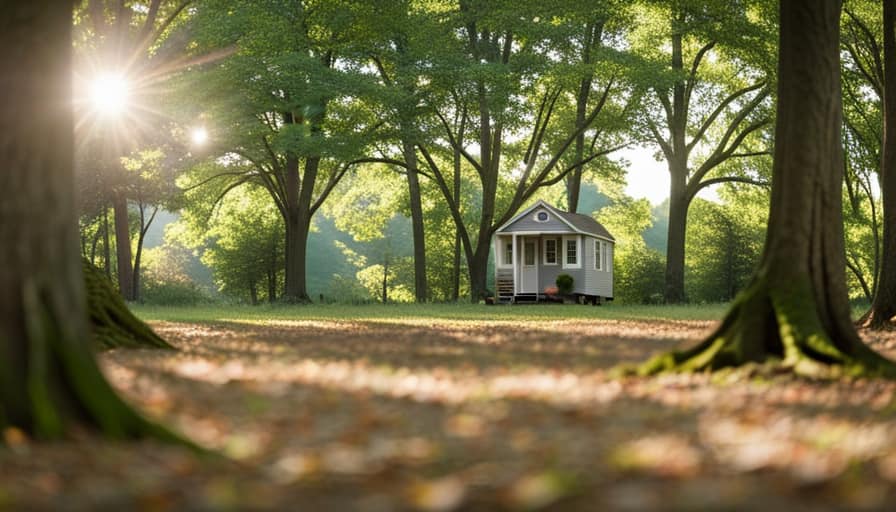
Are There Any Natural Remedies to Repel Ants?
I’ve found some effective natural remedies and DIY solutions to repel ants. These methods are great alternatives to chemical sprays and can help keep your home ant-free.
Are Ants Harmful to My Health?
Ants can have a negative impact on indoor air quality and pose potential risks in food storage areas. It is important to address ant infestations promptly to ensure the health and safety of your home.
Conclusion
In conclusion, the invasion of tiny ants into our homes can be attributed to their relentless search for food and water sources. Like tiny explorers, they navigate through common entry points and form trails and colonies indoors.
Understanding their behavior and the outdoor factors that attract them can help us prevent ant infestations. By employing effective strategies, we can create an inhospitable environment for these tiny intruders and maintain a harmonious home free from their presence.

I’m Theodore, and I love tiny houses. In fact, I’m the author of Tiny House 43, a book about tiny houses that are also tree houses. I think they’re magical places where imaginations can run wild and adventures are just waiting to happen.
While tree houses are often associated with childhood, they can be the perfect adult retreat. They offer a cozy space to relax and unwind, surrounded by nature. And since they’re typically built on stilts or raised platforms, they offer stunning views that traditional homes simply can’t match.
If you’re looking for a unique and romantic getaway, a tree house tiny house might just be the perfect option.
Required Materials
How Do Composting Toilet Tiny House

Upon entering my small abode, I had an epiphany about the necessity of incorporating sustainable practices into all aspects of my life. It was then that I stumbled upon the remarkable advantages of using a composting toilet.
In this article, I’ll share the science behind composting toilets, help you choose the right one, and guide you in designing an efficient system for your tiny house. Plus, I’ll provide valuable tips for maintenance and troubleshooting.
Let’s dive into the world of composting toilets and create a greener future together.
Key Takeaways
- Composting toilets in tiny houses save water and promote sustainability.
- The science behind composting toilets involves aerobic decomposition and regulation of temperature and moisture levels.
- There are different types of composting toilets available for tiny houses, including compact self-contained models and central composting toilets.
- Designing an efficient composting toilet system for a tiny house requires considerations such as adequate ventilation, easy cleaning and waste disposal, and compliance with local regulations.
The Benefits of a Composting Toilet in a Tiny House
One of the biggest benefits of having a composting toilet in my tiny house is that it saves me a significant amount of water. Traditional flush toilets use a large amount of water with every flush, but a composting toilet eliminates the need for water entirely.

This is especially advantageous in tiny houses, where water conservation is crucial due to limited resources. Additionally, composting toilets have the advantage of producing nutrient-rich compost, which can be used to fertilize plants and gardens. This eliminates the need for chemical fertilizers and reduces waste.
However, there are also a few disadvantages to consider. Composting toilets require regular maintenance and proper management to ensure proper composting and odor control. They may also have a learning curve for users who are unfamiliar with this type of toilet system.
Understanding the Science Behind Composting Toilets
As someone who lives in a tiny house with a composting toilet, I’m fascinated by the science behind how it works and the benefits it brings to sustainable living. Composting toilet technology utilizes a natural process to convert human waste into compost, which can then be safely used as fertilizer.
Here are four key aspects of the composting process:

-
Aerobic decomposition: Composting toilets create an environment that promotes the growth of beneficial bacteria and microorganisms. These organisms break down the waste into organic matter through aerobic decomposition, where oxygen is present.
-
Temperature regulation: The composting process requires specific temperature ranges to be effective. Composting toilets are designed to maintain the ideal temperature range of 40-60 degrees Celsius, ensuring efficient decomposition.
-
Moisture control: Proper moisture levels are essential for the composting process. Composting toilets have mechanisms to regulate moisture, such as ventilation systems and the addition of bulking agents like sawdust or coconut coir.
-
Odor prevention: Composting toilets are designed to minimize or eliminate odors. Effective ventilation systems and the presence of bacteria that consume odor-causing compounds help keep unpleasant smells at bay.
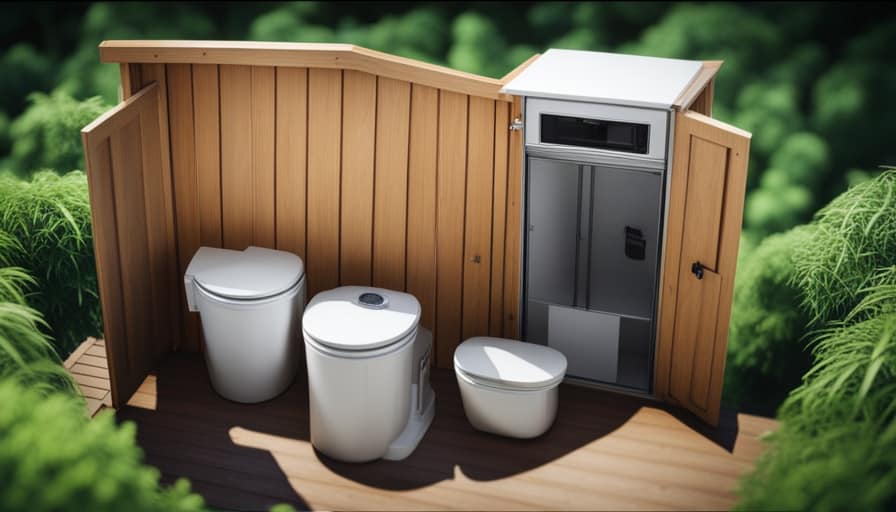
Understanding the science behind composting toilets is crucial for their effective operation and the production of nutrient-rich compost for sustainable gardening practices.
Choosing the Right Composting Toilet for Your Tiny House
When considering the options, I found that the most suitable composting toilet for my tiny house was a compact and self-contained model.
There are a few different types of composting toilets available, each with their own unique features and benefits.
The first type is the self-contained composting toilet, which is a popular choice for tiny houses due to its compact size and ease of installation. These toilets are designed to separate liquid and solid waste, using a ventilation system to promote decomposition and odor control.

Another option is the central composting toilet, which requires a separate composting unit outside of the tiny house. This type of toilet is typically more expensive and requires more complex installation, but it allows for larger capacity and longer periods between emptying.
Ultimately, the choice of composting toilet will depend on your specific needs and the available space in your tiny house.
Designing an Efficient Composting Toilet System for Your Tiny House
After researching different options, I decided that utilizing a compact and efficient composting toilet system would be the best choice for my tiny house. When designing an efficient composting toilet system, there are several key factors to consider:
-
Space: A compact design is essential for a tiny house. Look for composting toilets that have a small footprint and can fit comfortably within your bathroom layout.

-
Ventilation: Proper ventilation is crucial to control odor and promote the composting process. Ensure that your composting toilet system has adequate ventilation, either through a fan or a vent pipe, to maintain a fresh and odor-free environment.
-
Maintenance: Regular maintenance is necessary to keep your composting toilet system functioning efficiently. Look for a system that’s easy to clean and empty, with removable containers for composting material.
-
Composting Toilet Regulations: Before installing a composting toilet system in your tiny house, check local regulations and building codes. Some areas may have specific requirements for composting toilet installation, such as proper venting and waste disposal.
Tips for Maintaining and Troubleshooting Your Composting Toilet in a Tiny House
Maintaining and troubleshooting my composting toilet in a tiny house requires regular care and attention. To ensure its efficient operation, there are a few essential maintaining tips to keep in mind.
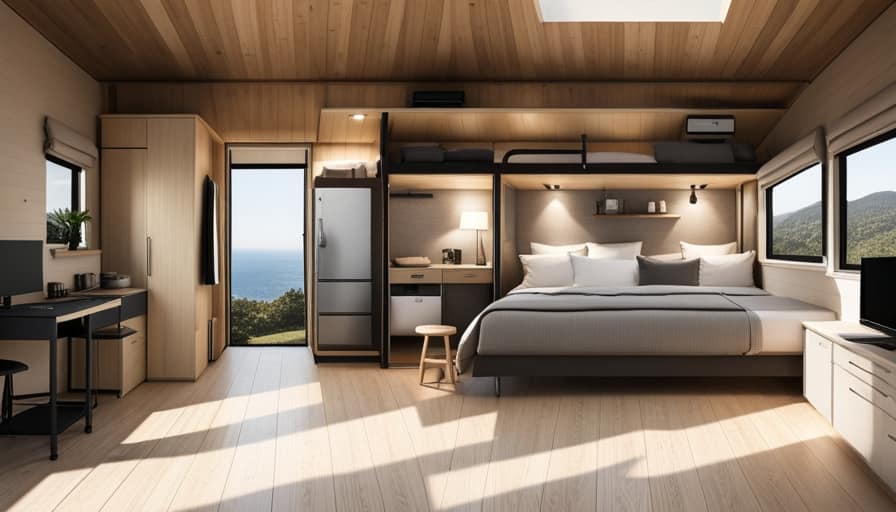
Firstly, it’s important to regularly check and clean the ventilation system to prevent any odors or blockages. Additionally, monitoring the moisture content in the compost is crucial. Maintaining the right balance between moisture and dry materials will help prevent any potential issues.
Another tip is to regularly empty the composting chamber to avoid overloading and maintain proper decomposition.
When it comes to troubleshooting, if there are any foul odors, it might indicate an imbalance in the compost mixture or insufficient ventilation. Adjusting the compost mixture or increasing ventilation can help resolve this issue. If there are any mechanical problems, it’s best to consult the manufacturer or a professional for assistance.
Frequently Asked Questions
How Much Does a Composting Toilet Cost?
The cost of a composting toilet varies depending on the brand and features. However, the benefits of composting toilets, such as reduced water usage and the production of nutrient-rich compost, make them a worthwhile investment.

Are Composting Toilets Legal in All Areas?
Composting toilets offer a sustainable solution for waste management. While there may be regulations regarding their use in certain areas, the benefits of composting toilets, such as reducing water usage and providing nutrient-rich soil, outweigh any restrictions.
How Often Do I Need to Empty a Composting Toilet?
I empty my composting toilet every 2-3 months. Regular maintenance ensures optimal performance and prevents odor. Composting toilets are beneficial as they save water, produce nutrient-rich compost, and are environmentally friendly alternatives to traditional flush toilets.
Can I Use Regular Toilet Paper in a Composting Toilet?
Regular toilet paper can be used in a composting toilet, but it may take longer to break down. To maintain the system, consider alternatives like biodegradable toilet paper or even reusable cloth wipes.
Are Composting Toilets Odorless?
Composting toilets have numerous benefits, such as reducing water usage and producing nutrient-rich compost. However, they do require regular maintenance to control odor, through proper ventilation, adding bulking material, and ensuring proper decomposition.

Conclusion
In conclusion, embracing the use of a composting toilet in your tiny house is a wise decision that not only benefits the environment but also offers a practical solution for waste management.
By understanding the science behind composting toilets and selecting the right one for your needs, you can design an efficient system that requires minimal maintenance.
So, take the plunge and let your tiny house become a haven of sustainability and innovation. You’ll be flushing away traditional waste systems and embracing a greener future.
I’m Theodore, and I love tiny houses. In fact, I’m the author of Tiny House 43, a book about tiny houses that are also tree houses. I think they’re magical places where imaginations can run wild and adventures are just waiting to happen.
While tree houses are often associated with childhood, they can be the perfect adult retreat. They offer a cozy space to relax and unwind, surrounded by nature. And since they’re typically built on stilts or raised platforms, they offer stunning views that traditional homes simply can’t match.
If you’re looking for a unique and romantic getaway, a tree house tiny house might just be the perfect option.
Expert Tips
How Do I Anchor My Tiny House on Wheels

Are you curious about how to safely secure your tiny house on wheels? Look no further!
In this article, I’ll guide you through the different types of anchoring systems and help you choose the best method for your needs.
With a step-by-step approach, I’ll show you how to anchor your tiny house for stability and safety, even in windy conditions.
Plus, I’ll share maintenance tips to ensure your anchoring system remains reliable.

Let’s get started on keeping your tiny house grounded!
Key Takeaways
- There are various types of anchoring systems available for tiny houses on wheels, including screw-in ground anchors, concrete footings, heavy-duty straps or cables, and ground anchors.
- Factors such as soil composition, climate conditions, building codes, house weight, and accessibility should be considered when choosing an anchoring system for a tiny house on wheels.
- The installation process typically involves site preparation, marking anchor points, digging holes or drilling, installing anchors, and securing the house.
- Regular maintenance and inspection are necessary for ensuring the stability and safety of the anchoring system, including inspections, tightening hardware, repairing or replacing damaged anchors, cleaning and removing debris, and monitoring soil erosion.
Different Types of Anchoring Systems
I’ll discuss the different types of anchoring systems for my tiny house on wheels.
When it comes to anchoring a tiny house, there are several innovative solutions available that provide stability and security.
One common option is using screw-in ground anchors, which are versatile and easy to install. These anchors are driven into the ground and provide a strong hold, even on uneven terrain.

Another option is using concrete footings, which provide a solid foundation for the house. These footings can be poured directly into the ground or placed on top of pre-existing concrete pads.
Additionally, using heavy-duty straps or cables can help anchor the house to nearby trees or other structures. These solutions address the challenges of anchoring on uneven terrain by providing stability and preventing movement.
Factors to Consider When Choosing an Anchoring Method
Considering the terrain and weather conditions is crucial when selecting an anchoring method for my tiny house on wheels. The effectiveness of the anchoring method depends greatly on the composition of the soil. Here are three factors to consider when choosing an anchoring method:
-
Soil composition: Different soils have different load-bearing capacities. It’s important to understand the soil composition of the site where the tiny house will be parked. Clay soils, for example, tend to expand and contract with moisture changes, which can affect the stability of the anchoring system.

-
Cost comparison: Each anchoring method has its own pros and cons in terms of cost. Concrete footings may provide a strong and durable foundation, but they can be expensive and time-consuming to install. On the other hand, screw-in anchors are relatively affordable and quick to install, but they may not be suitable for all soil types.
-
Weather resistance: The anchoring method should be able to withstand various weather conditions, including strong winds and heavy rain. It’s important to choose a method that’s designed to handle the specific weather patterns of the area where the tiny house will be located.
Considering these factors will help me make an informed decision about the most suitable anchoring method for my tiny house on wheels.
Step-by-Step Guide to Anchoring Your Tiny House on Wheels
First, I’ll outline the step-by-step guide to anchoring my tiny house on wheels. This guide will provide you with cost-effective anchoring options and DIY anchoring techniques that you can easily implement.

Here is a table that breaks down the steps involved:
| Step | Description |
|---|---|
| 1 | Choose the right anchoring method based on your location and soil type. |
| 2 | Prepare the ground by clearing any debris and leveling the area. |
| 3 | Dig holes for the anchor points, ensuring they are deep enough for stability. |
| 4 | Install ground anchors or concrete footings in the holes, following manufacturer instructions. |
| 5 | Attach the anchor points to your tiny house, ensuring a secure connection. |
Tips for Ensuring Stability and Safety in Windy Conditions
To ensure stability and safety in windy conditions, I always securely anchor my tiny house on wheels using additional tie-downs and wind-resistant materials. Here are some tips for ensuring stability and safety in windy conditions:
-
Wind resistant design features for tiny houses:
-
Install hurricane straps to reinforce the connection between the walls and the foundation.

-
Use impact-resistant windows and doors to minimize the risk of breakage.
-
Opt for a low-profile design to reduce wind resistance.
-
Emergency measures for securing a tiny house in extreme weather:
-
Have a plan in place to evacuate the area if severe weather is approaching.

-
Use additional anchors or ground screws to provide extra stability.
-
Secure loose items around the house and remove any nearby trees or branches that could pose a risk.
Maintaining and Inspecting Your Anchoring System: Best Practices
I regularly perform inspections and maintenance on my anchoring system to ensure its effectiveness and reliability. Inspecting anchors is an essential part of maintaining the stability and safety of my tiny house on wheels.
During inspections, I carefully examine each anchor for any signs of damage or wear. This includes checking for rust, loose bolts, or bent components. If I notice any issues, I promptly address them by replacing or repairing the affected parts.

Additionally, I make sure to clean and lubricate the anchors regularly to prevent corrosion and ensure smooth operation. Anchoring system maintenance also involves checking the tension of the tie-down straps and adjusting them if necessary.
Frequently Asked Questions
Can I Use the Same Anchoring System for My Tiny House on Wheels as I Would for a Traditional Home?
I can’t use the same anchoring system for my tiny house on wheels as I would for a traditional home. I need to explore alternative anchoring methods and consider the pros and cons of different anchoring systems.
What Should I Do if My Tiny House Is Parked on Uneven Terrain?
If my tiny house is parked on uneven terrain, I need to consider alternative anchoring methods. Leveling the house is crucial, but it has its pros and cons. Let’s explore the options and find the best solution.
Are There Any Regulations or Permits I Need to Consider When Anchoring My Tiny House on Wheels?
When anchoring my tiny house on wheels, I need to consider the regulations and permits that may be required. I must ensure that the anchoring system is secure enough to withstand extreme weather conditions and moving, while also being suitable for both temporary and permanent setups.

How Do I Know if My Anchoring System Is Secure Enough to Withstand Extreme Weather Conditions?
To ensure my anchoring system can withstand extreme weather conditions, I must assess its security. It is important to consult with professionals who can provide detailed guidance on the strength and effectiveness of the system.
Can I Move My Tiny House on Wheels After It Has Been Anchored, or Is the Anchoring System Permanent?
I can move my tiny house on wheels after it’s been anchored. The anchoring system has both permanent and temporary options. It provides stability during extreme weather conditions and allows for relocation when needed.
Conclusion
In conclusion, anchoring your tiny house on wheels is crucial for ensuring stability and safety.
By carefully selecting the appropriate anchoring system and following a step-by-step guide, you can secure your tiny house in place.

For example, in a case study, a tiny house owner used a combination of ground screws and tie-downs to anchor their house in a windy area, successfully withstanding strong gusts of wind without any movement or damage.
Regular maintenance and inspections are also essential for the long-term reliability of your anchoring system.
I’m Theodore, and I love tiny houses. In fact, I’m the author of Tiny House 43, a book about tiny houses that are also tree houses. I think they’re magical places where imaginations can run wild and adventures are just waiting to happen.
While tree houses are often associated with childhood, they can be the perfect adult retreat. They offer a cozy space to relax and unwind, surrounded by nature. And since they’re typically built on stilts or raised platforms, they offer stunning views that traditional homes simply can’t match.
If you’re looking for a unique and romantic getaway, a tree house tiny house might just be the perfect option.
-

 Beginners Guides2 weeks ago
Beginners Guides2 weeks agoHow To Buy A Tesla Tiny House
-

 Energy Efficiency2 months ago
Energy Efficiency2 months agoBest Tiny Homes For Cold Climates
-

 Beginners Guides2 weeks ago
Beginners Guides2 weeks agoTiny House Nation Where Are They Now Stephanie
-

 Tiny House Resources (e.g., legalities, cost, insurance, FAQs)2 months ago
Tiny House Resources (e.g., legalities, cost, insurance, FAQs)2 months agoDo Tiny Homes Need Planning Permission?
-

 Beginners Guides3 weeks ago
Beginners Guides3 weeks agoFrom The Show Tiny House Nation How Many Keep Their Tiny House?
-

 Beginners Guides2 months ago
Beginners Guides2 months agoUsing a Climbing Net For Treehouse Construction
-

 Beginners Guides2 months ago
Beginners Guides2 months agoHow to Build a Treehouse Without Drilling Into the Tree
-

 Beginners Guides4 weeks ago
Beginners Guides4 weeks agoTiny House Nation Who Pays For The Houses







